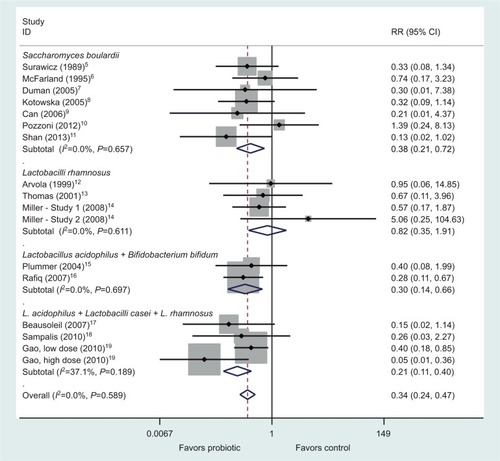Dear editor
I read with great interest the systematic review of meta-analysis assessing probiotics for the prevention of Clostridium difficile-associated diarrhea (CDAD) published in the International Journal of General Medicine.Citation1 These authors pooled 26 randomized controlled trials (RCTs) and concluded that Lactobacilli, mixtures, and Saccharomyces probiotics were effective in preventing CDAD. However, the meta-analysis by Lau and Chamberlain is flawed due to improper classification by the types of probiotics. It is important to recognize that the efficacy of probiotics for various diseases has been shown to be strain specific for each probiotic product, and thus the data should only be pooled for probiotics that are of the identical type.Citation2,Citation3 In their analysis of probiotic subgroups by various species, the authors have inappropriately merged different types of Lactobacilli into one subgroup “Lactobacilli” and different types of mixtures into one group classified as “Mix”. The Lactobacilli subgroup actually contains RCTs using six different types of Lactobacilli: Lactobacilli rhamnosus GG (three RCTs), one mixture of three Lactobacilli strains (Lactobacilli acidophilus CL1285, Lactobacilli casei LBC80R, and L. rhamnosus CLR2) (three RCTs), L. acidophilus (one RCT), one mixture of three strains of L. rhamnosus (E/n, Oxy, and Pen) (one RCT), L. casei Shirota (one RCT), and Lactobacilli plantarum 299v (one RCT). The Mix subgroup contains RCTs of five different types of strains, and only two trials evaluated the same type of probiotic mixture (L. acidophilus and Bifidobacterium bifidum). Only the Saccharomyces subgroup correctly pooled seven RCTs using the same strain of probiotic (Saccharomyces boulardii CNCM I-745). When these subgroups are pooled appropriately, as shown in , only three types of probiotics have efficacy for the primary prevention of CDAD: S. boulardii (P=0.003) and two mixtures (BioK+, a mixture of three Lactobacilli strainsCitation4 [P<0.001] and the mixture of L. acidophilus with B. bifidum [P=0.002]). L. rhamnosus GG did not significantly prevent CDAD (P=0.65), a finding that is not apparent in the meta-analysis presentation of Lau and Chamberlain. No other probiotic strains had a second confirmatory RCT, and hence it is inappropriate to pool these different strains together. Only by appropriately combining and pooling data using the same strain or strains of probiotics can practical clinical guidance be determined as to which specific probiotic strains can be used to prevent CDAD.
Figure 1 Forest plot of 15 randomized controlled trials by four probiotic subgroups for the primary prevention of Clostridium difficile disease. Adapted from Lau CS, Chamberlain RS. Probiotics are effective at preventing Clostridium difficile-associated diarrhea: a systematic review and meta-analysis. Int J Gen Med. 2016;9:27–37.Citation1

Disclosure
The author is on the Scientific Advisory Board of Biok+ and a paid lecturer of Biocodex. The author reports no other conflicts of interest in this communication.
Dear editor
We appreciate the editorial comments and suggestions by McFarland included here, as well as the ability to respond to their critique. This author makes several valid points about the type of data, which is clearly needed to better understand the impact of specific probiotics on Clostridium difficle-associated diarrhea (CDAD) prevention. The previously published meta-analysis entitled “Probiotics are effective at preventing Clostridium difficile-associated diarrhea: a systematic review and meta-analysis” was performed to evaluate the impact of probiotics on CDAD.Citation1 Given existing data, the only means to answer this question via meta-analysis required that all existing data be pooled. That said, we also conducted a subgroup analysis based on the genus of probiotic, to determine which probiotic genus (Lactobacillus, Bifidobacterium, and Saccharomyces) were most beneficial at preventing CDAD. The category “mixture of probiotics” included strains from more than one probiotic genus. As suggested by McFarland in their editorial, additional more detailed subgroup analysis based on unique probiotic species would be ideal; however, given the variation in specific species utilized in published reports, the paucity of published randomized control trials (RCTs) evaluating each species, and the fact that the vast majority of all published RCTs included a combination of different probiotic species, a subgroup analysis by probiotic species was not possible.
As mentioned in the “Discussion” section, there are limitations to our published report, as well as limitations that are inherent to meta-analyses in general. The specific strains, dosages, and duration of probiotic regimen differed widely. Ideally, the best way to determine the optimal probiotic regimen would be to conduct RCTs comparing specific strains and dosages of probiotics. Given the limited availability of such data, the next-best method is the use of a subgroup analysis. The original article demonstrated the effectiveness of probiotics in reducing the risk of CDAD, and a subgroup analysis identified different efficacies based on probiotic genus.Citation1 More recently, McFarland reported that there were efficacy differences based on specific species – and that S. boulardii, BioK+ mixture, a mixture of three Lactobacilli strains, and a mixture of L. acidophilus plus B. bifidum are beneficial at reducing the risk of CDAD, while L. rhamnosus GG does not significantly reduce the risk of CDAD.
Disclosure
The authors report no conflicts of interest in this communication.
Reference
- LauCSChamberlainRSProbiotics are effective at preventing Clostridium difficile-associated diarrhea: a systematic review and meta-analysisInt J Gen Med20169273726955289
